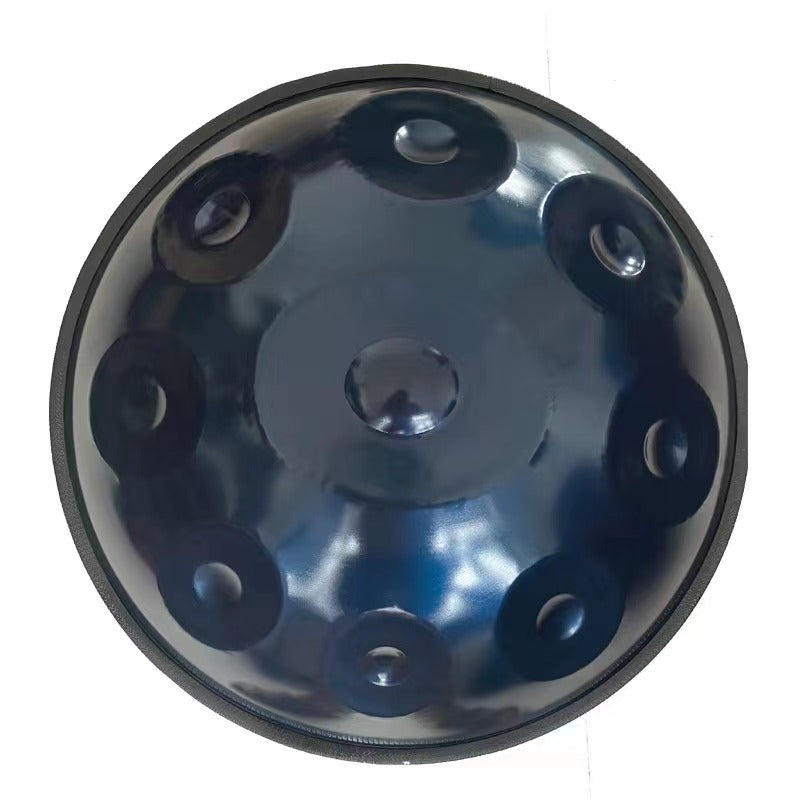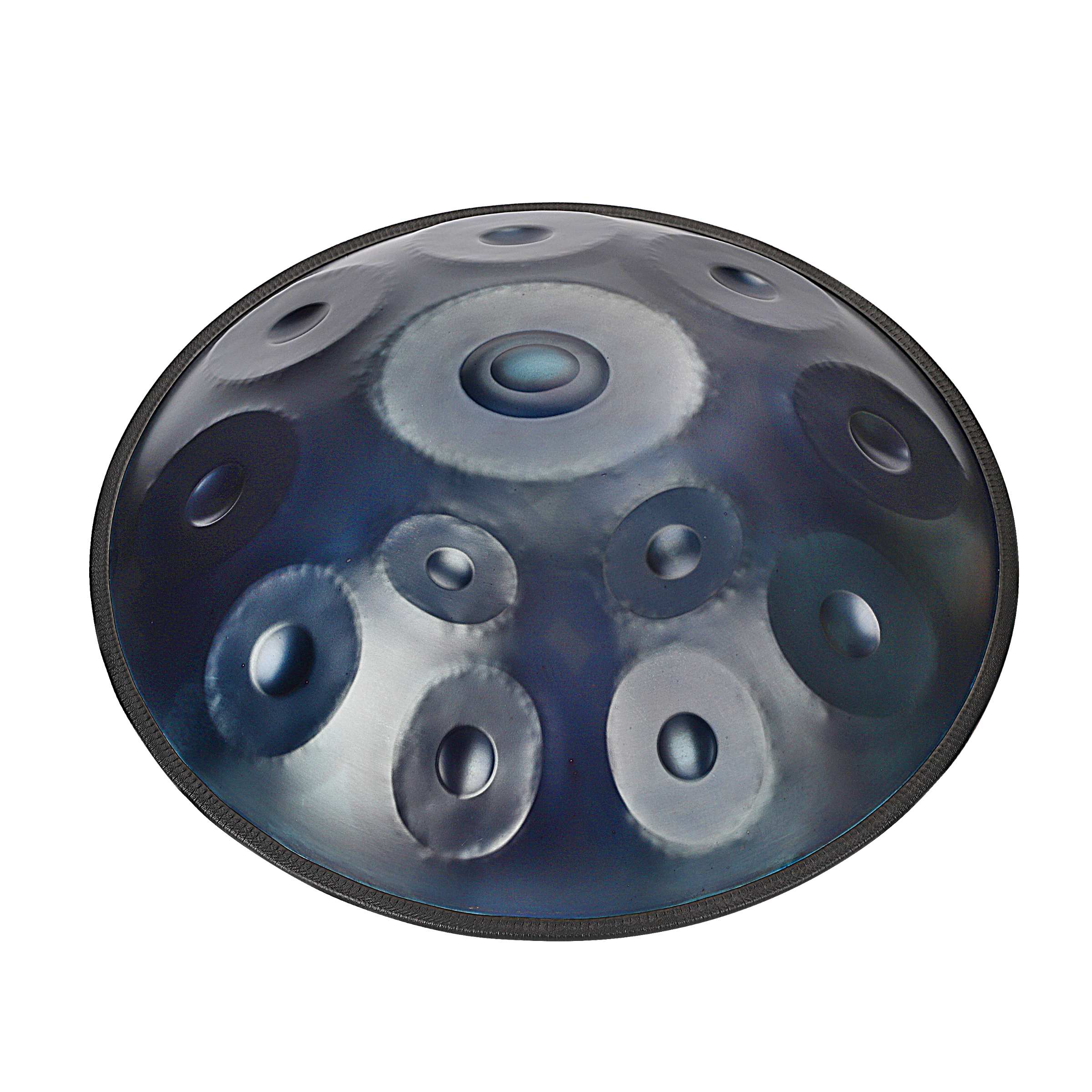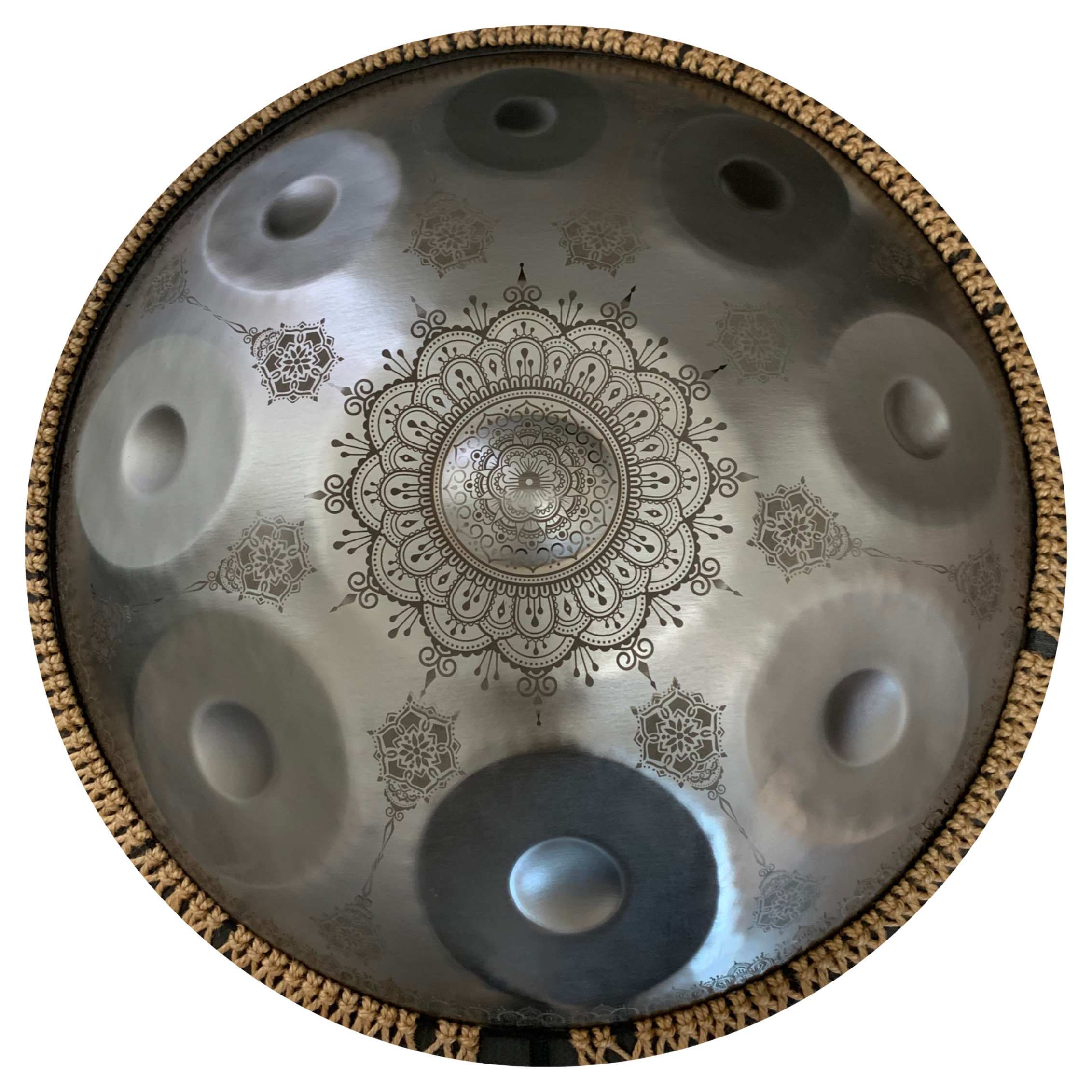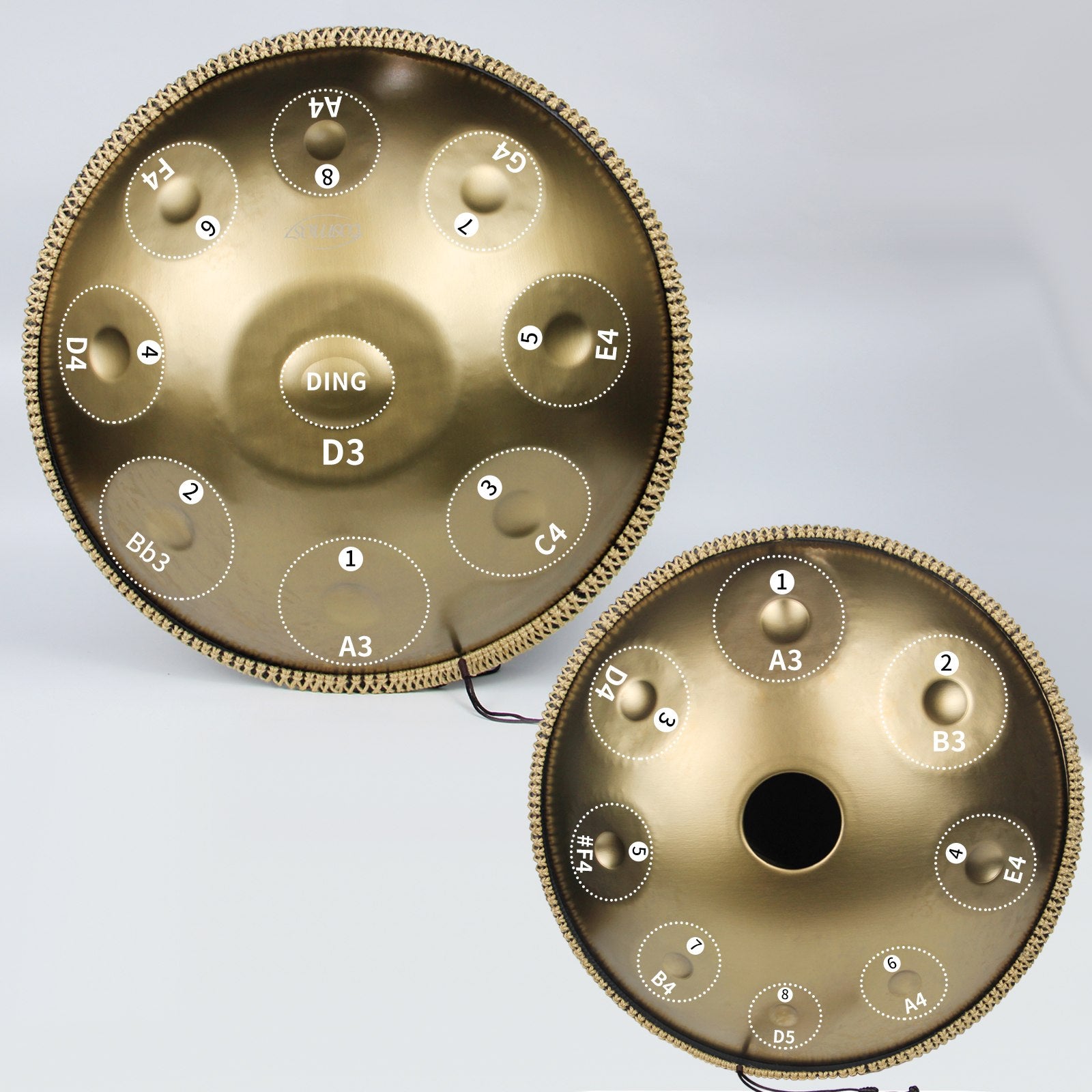Découvrir votre son de batterie idéal est un processus qui implique une part de compréhension technique et deux parts d'émotion. Voici quelques conseils qui peuvent vous aider à obtenir le meilleur de votre son de batterie.

Comprendre l'accordage des tambours
Bases de l'accordage : Tout d'abord, avant de jouer du handpan, il faut définir l'accordage comme le point de départ pour créer un son de tambour qui vous conviendrait parfaitement. Chaque tambour individuel a certains paramètres qui sont les plus préférables pour la résonance, et la taille générale et le matériau du cadre comptent également. L'accordage est un processus de tension qui est réglé sur la peau de frappe ou la tête supérieure et la peau résonante ou la tête inférieure pour obtenir la bonne hauteur et le bon ton. Pour obtenir un bon résultat, commencez par égaliser d'abord la tête de frappe, puis, par la suite, égalisez la tête résonante.
Intervalles de réglage : Le réglage des intervalles sur vos toms influencera considérablement les résonances totales de votre batterie. Pour s'assurer que les tambours sonnent en harmonie les uns avec les autres, il existe des intervalles couramment joués, tels que la quarte juste ou la quinte juste. Par exemple, avec le tom le plus élevé accordé à une hauteur spécifique, le tom suivant devrait idéalement être accordé une quarte plus bas que le précédent (ce qui correspond à cinq demi-tons). Cela aide à développer un bon son lisse à travers l'ensemble de votre kit.
L'attrait des handpans
Le handpan est un instrument de musique absolument extraordinaire et universel qui peut être décrit comme étant extrêmement populaire aujourd'hui en raison de son timbre plutôt inspirant. Le handpan appartient à la famille des tambours en acier, et il a une structure entièrement différente et 8 ou 9 tonalités accordées ; par conséquent, il fournit des notes appropriées pour les amateurs de musique et les guérisseurs par le son. Les handpans peuvent être très fascinants pour quelqu'un de nouveau dans la gamme des instruments de percussion, donc un handpan pour un débutant serait un point de départ parfait pour le spectre infini de la musique. Beaucoup de ces modèles initiaux sont intentionnellement conçus pour être simples à utiliser afin que les personnes ayant peu d'expérience musicale puissent créer une musique apaisante et agréable. Que quelqu'un recherche des vacances ou crée une œuvre d'art, le handpan offre un bon rendement en tant qu'instrument de musique.
Choisir les bonnes peaux de tambour
Types de peaux de tambour : J'ai dû apprendre que cet élément détermine le son d'un individu de manière très dramatique. Les profils avec une seule couche de la peau donnent un ton brillant et ouvert du tambour, tandis que la double couche de la peau la rend plus résistante à l'usure et fournit le son profond et chaud du tambour. De plus, les peaux enduites délivrent un ton plus chaud ainsi qu'un ton étouffé ; en revanche, les peaux transparentes donneront un ton plus brillant avec un son plus axé sur l'attaque.
Remplacement des peaux de tambour : Vous devez faire changer vos peaux de tambour régulièrement pour obtenir le meilleur son de vos tambours. Les peaux de frappe, sur lesquelles les baguettes reposent lors des frappes, doivent être changées tous les six mois à un an selon le niveau de jeu ; en revanche, les peaux résonnantes, bien qu'elles puissent durer plus longtemps, doivent être changées tous les deux ou trois changements de peaux de frappe.
Expérimenter avec des techniques d'accord
Accord relatif et accord absolu : L'accord à la hauteur signifie accorder vos tambours de manière à ce qu'ils produisent un ensemble de hauteurs bonnes et harmonisées. Alors que l'accord absolu accorde chacun des tambours à une hauteur définie. Les deux sont efficaces et, en prenant le temps d'essayer les méthodes spécifiques, ils seront en mesure de découvrir le son qui leur convient.
Utilisation des accordeurs de batterie : Chacun des outils associés, tels que les accordeurs de batterie, peut aider à obtenir un accordage précis. Des gadgets tels que le Tune-Bot confirment la fréquence des peaux de batterie, puis vous accordez chaque tirant à la même hauteur pour une symétrie sonore de la batterie.
Techniques d'amortissement
Contrôle des harmoniques : En fait, les harmoniques peuvent créer un son quelque peu chaotique si elles ne sont pas tempérées sur les tambours. Il est également possible d'atténuer les résonances, par exemple, en appliquant des gels lunaires, des oreillers internes de grosse caisse, ou même en mettant une serviette sur la peau du tambour. L'objectif ici est d'obtenir une attaque précise et définie du tambour sans trop de résonance.
Mixage et Enregistrement
Niveaux d'équilibre : Lorsque vous mixez vos percussions, il faut être très prudent avec le type d'équilibre appliqué à la piste. Le niveau sonore de chaque batterie doit être audible, mais en même temps, les autres instruments ne doivent pas être facilement audibles. En général, la grosse caisse et la caisse claire doivent être les éléments les plus dominants du mix, car elles forment le rythme principal des instruments. Ainsi, égaliser le niveau des toms et des cymbales permettra d'obtenir les sons de batterie idéaux et de réaliser la bonne combinaison.
Panoramique : Le panoramique peut effectivement apporter la profondeur et l'espace nécessaires à votre mixage de batterie. La grosse caisse et la caisse claire sont généralement placées au centre, tandis que les toms, les hi-hats et les cymbales sont panoramiques sur le champ stéréo. Cela crée un environnement naturel pour l'instrument, de sorte que lorsque vous écoutez les batteries, cela donne l'impression et le son d'un cadre réel.
Utiliser l'EQ : L'égalisation, ou EQ comme on l'appelle couramment, est très importante en ce qui concerne l'accord tonal de vos batteries. Déterminez la hauteur des batteries et utilisez l'égalisation pour augmenter les fréquences respectives afin que la batterie puisse être facilement distinguée des autres éléments dans le mix. D'autre part, réduire les fréquences qui causent des problèmes aide souvent à réduire les interférences et permet également à chaque tom d'avoir son espace sur la piste.
Compression : La compression aide à contrôler la plage dynamique de vos batteries afin que chaque coup ait le même volume. Il est recommandé de d'abord définir une valeur modérée comme ratio et de s'assurer que le but du compresseur est de s'activer uniquement lors des coups les plus forts. En ce qui concerne les batteries, chaque coup nécessite une attaque et un relâchement différents ; par exemple, les caisses claires doivent avoir une attaque rapide pour capturer le transitoire, mais la puissance de la grosse caisse peut être ressentie avec une attaque lente.
Compression parallèle : Dans cette technique, il est nécessaire de prendre une version beaucoup plus brute des percussions et de la mélanger avec la piste originale. Cela ajoute de la densité ou de la résonance, ce qui rend vos percussions plus ciblées et puissantes, sans compromettre l'intégrité tonale.
Trouver le Handpan Parfait à Vendre
La popularité croissante de cet instrument fascinant signifie qu'un handpan peut être facilement acheté aujourd'hui. Il existe de nombreux magasins en ligne et des magasins de musique spécialisés par lesquels vous pouvez acheter différents types de handpans en fonction des préférences, des compétences et des intérêts musicaux de chacun. Lorsqu'on essaie de trouver le bon handpan pour un joueur débutant, l'échelle, le matériau ainsi que l'artisanat doivent également être pris en compte pour la meilleure expérience avec cet instrument. La plupart des vendeurs s'assurent de donner des descriptions détaillées des articles disponibles et parfois offrent aux acheteurs des échantillons de ce à quoi ils peuvent s'attendre. Les handpans peuvent être appréciés pendant très longtemps car choisir et acheter le bon est l'un des éléments les plus précieux dans les instruments des musiciens.
Commencer votre voyage musical avec un handpan pour débutants
Commencer le processus d'apprentissage à jouer des instruments de musique avec le handpan, dans ce cas, est une excellente façon d'apprendre à faire de la musique. Ces instruments sont conçus pour être accessibles aux apprenants, et il ne faut pas beaucoup d'efforts pour maîtriser ces instruments. Peu importe si vous n'avez jamais joué d'un instrument de musique ou si vous avez l'habitude d'en jouer, un handpan pour débutant peut vous aider à vous familiariser avec ce type d'instrument spécial. La plupart des handpan à vendre incluent des instructions ou des liens vers des vidéos en ligne qui peuvent aider le nouveau joueur de handpan à apprendre à jouer du handpan. Vers le milieu des leçons, vous réaliserez que le handpan peut être utilisé de manière très polyvalente en tant qu'instrument.
Dernières pensées
Obtenir ce son de batterie ultime nécessite de comprendre comment accorder une batterie, les peaux de batterie appropriées, une bonne technique, et probablement les meilleurs équipements comme l'égaliseur et la compression. Il est également essentiel d'effectuer des pratiques générales pour votre équipement, y compris le remplacement des peaux de batterie et le nettoyage de vos batteries.
Cependant, notez que chacun a sa propre idée de ce qui produit le meilleur son. Ce qui peut convenir à un batteur particulier peut ne pas être acceptable pour le suivant, il est donc sage d'essayer tout et de se fier à ce qui sonne bien. Dans ce cas, en essayant d'appliquer ces conseils et en ajustant également le processus à chaque fois, on sera en bonne position pour obtenir le meilleur son de batterie qui peut correspondre à leur genre musical.







